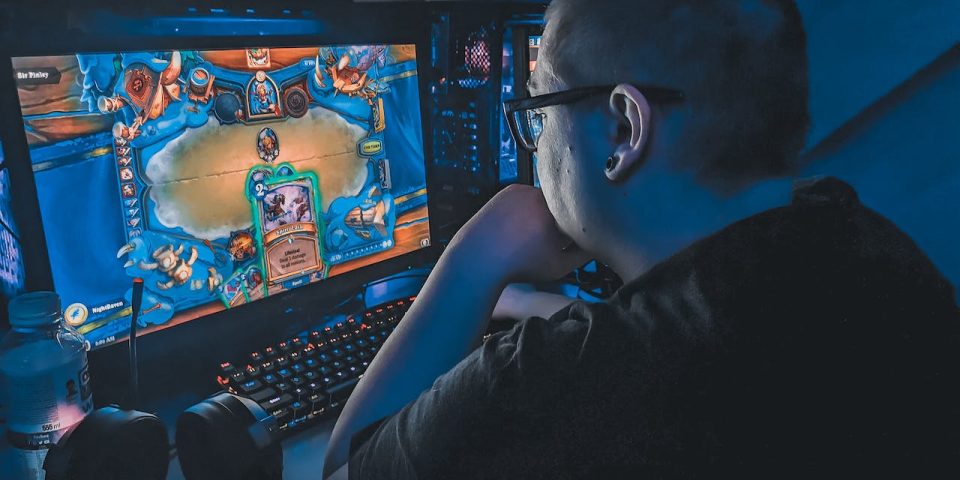Demystifying Latency: What it Means for Online Gaming and Streaming
Gaming

![]() Posted by: Kosciusko Connect
2 years ago
Posted by: Kosciusko Connect
2 years ago
In the world of online gaming and streaming, one word that often gets thrown around is “latency.” But what exactly does it mean, and why is it important? In this article, we aim to demystify latency and shed light on how it impacts your gaming and streaming experience.
Latency refers to the delay between an action and its response. In online gaming, it could mean the difference between victory and defeat. Even a slight delay can throw off your aim or reaction time, giving your opponents the upper hand. Similarly, in streaming, high latency can result in buffering and interruptions, ruining your binge-watching session.
Understanding latency is crucial for gamers and streamers alike. By knowing how it affects performance and what factors contribute to it, you can make informed choices to optimize your setup. From internet connection quality to server location, various factors can influence latency. This is true whether you live in Kosciusko County, other parts of Indiana, or somewhere else altogether.
So, if you’re tired of laggy gameplay or buffering streams, join us as we explore the world of latency and discover how you can minimize its impact. Prepare to take your gaming and streaming experience to the next level.
What is latency?
Latency is the time it takes for data to travel from your device to the server and back. It is measured in milliseconds (ms). In online gaming, low latency is essential for smooth and responsive gameplay. When you press a button or move your mouse, you expect an immediate reaction on the screen.
However, latency can vary depending on your internet connection and the distance between your device and the game server. The longer the distance, the higher the latency. This delay can be frustrating, especially in fast-paced games where split-second decisions matter.
To put it simply, latency is the enemy of real-time interaction. It disrupts the flow of the game and hampers your ability to react quickly. Whether you’re playing competitively or casually, minimizing latency should be a priority.

The impact of latency on gaming and streaming experiences
High latency can have a significant impact on your gaming and streaming experiences. In gaming, it can lead to input lag, where there is a noticeable delay between your actions and the game’s response. This delay can affect your aim, movement, and overall gameplay performance.
Imagine you’re playing a first-person shooter game, and there’s a delay between when you click the mouse to shoot and when the gun fires. This delay can throw off your aim, causing you to miss crucial shots. In competitive gaming, where split-second reactions are crucial, even a small amount of latency can give your opponents the upper hand.
In streaming, high latency can result in buffering and interruptions. When watching a live stream or a movie, buffering breaks the flow of the content and can be extremely frustrating. It disrupts the immersion and takes away from the overall viewing experience.
Factors that contribute to latency
Several factors contribute to latency in online gaming and streaming. Understanding these factors can help you identify potential bottlenecks and optimize your setup for the best possible performance. Here are some key factors to consider:
- Internet connection: The quality and speed of your internet connection play a significant role in latency. A faster connection with low latency can provide a smoother gaming and streaming experience. You’ll want to choose an ISP like Kosciusko Connect that offers high-speed fiber internet plans with low latency, especially if you’re a serious gamer or streamer.
- Server location: The physical distance between your device and the game server or streaming platform can impact latency. If the server is located far away, the data has to travel a longer distance, resulting in higher latency. Choosing servers closer to your location can help reduce latency.
- Network congestion: The level of network congestion can affect latency. During peak hours or in areas with heavy internet traffic, latency can increase due to the higher number of data packets being transmitted. Opting for a less congested network can help reduce latency.
- Hardware and software configuration: The hardware and software you use can also contribute to latency. Outdated or underpowered devices may struggle to handle the demands of modern games and streaming platforms, leading to higher latency. Ensure that your hardware meets the recommended specifications for gaming and streaming to minimize latency.
- Wireless vs. wired connection: Wireless connections are generally more prone to latency compared to wired connections. If possible, consider using a wired Ethernet connection for gaming and streaming to reduce latency.
How latency is measured
To measure and understand latency, several metrics come into play. Here are three important metrics that can help you assess and monitor latency:
- Ping: Ping measures the time it takes for a data packet to travel from your device to the server and back. It is measured in milliseconds (ms). Lower ping values indicate lower latency. You can use online tools or the command prompt to test your ping to a specific server.
- Jitter: Jitter refers to the variation in ping over time. It measures the consistency of latency. High jitter can result in inconsistent performance, leading to lag spikes and gameplay disruptions. Lower jitter values indicate more stable latency.
- Packet loss: Packet loss occurs when data packets get lost or fail to reach their destination. It can result in missing or delayed information, leading to a degraded gaming or streaming experience. Minimizing packet loss is crucial for reducing latency.
Monitoring these metrics can help you identify latency issues and take appropriate actions to optimize your setup.

Ways to reduce latency for online gaming and streaming
Now that we understand the impact of latency and the factors contributing to it, let’s explore some ways to reduce latency for online gaming and streaming:
- Optimize your internet connection: Choose a reliable ISP like Kosciusko Connect with low latency and high-speed internet plans. Consider upgrading to a faster connection if necessary. Kosciusko Connect offers affordably-priced Advanced and Premium plans that offer 500 – 1,000 Mbps. If you’re using Wi-Fi, ensure that you’re close to the router and minimize interference from other devices.
- Choose servers closer to your location: When gaming or streaming, select servers that are geographically closer to your location. This reduces the physical distance between your device and the server, resulting in lower latency.
- Upgrade your hardware: If you’re experiencing high latency, consider upgrading your hardware. A more powerful processor, additional RAM, and a dedicated graphics card can improve performance and reduce latency.
- Use a wired connection: Whenever possible, use a wired Ethernet connection instead of Wi-Fi. Wired connections offer lower latency and more stable performance, especially during intense gaming or streaming sessions.

- Close unnecessary background applications: Running multiple applications in the background can consume system resources and increase latency. Close any unnecessary applications to free up resources and improve performance.
- Enable Quality of Service (QoS): Quality of Service settings in your router can prioritize gaming and streaming traffic, reducing latency during online sessions. Kosciusko Connect’s Guardian Protection add-on allows users to prioritize every device connected to their network. With Guardian it’s easy to set a priority for your important devices when you need them to ensure that you have all the bandwidth you need.
By implementing these strategies, you can significantly reduce latency and improve your gaming and streaming experiences.
Latency in different gaming platforms: PC, console, and mobile
Latency can vary across different gaming platforms, with each having its own unique considerations. Here’s a closer look at latency in PC, console, and mobile gaming:
- PC gaming: PC gaming offers a wide range of customization options, allowing players to optimize their setup for low latency. With powerful hardware and the ability to choose servers, PC gamers have more control over reducing latency. However, factors like outdated hardware or an underperforming network connection can still lead to high latency.
- Console gaming: Consoles offer a more streamlined and standardized gaming experience compared to PCs. While console gamers may have limited control over server selection, they can still optimize their network connection and hardware for low latency. Choosing a console with built-in Wi-Fi or using a wired connection can help reduce latency.
- Mobile gaming: Mobile gaming has gained popularity in recent years, with smartphones becoming powerful gaming devices. However, mobile gaming often relies on wireless connections, which can introduce higher latency compared to wired connections. Using a Wi-Fi connection instead of mobile data and ensuring a stable signal can help reduce latency.
Regardless of the platform, understanding the factors that contribute to latency and implementing the strategies mentioned earlier can help improve the gaming experience.

Popular streaming platforms and their latency issues
Streaming platforms have revolutionized how we consume media, but they also come with their own latency challenges. Let’s take a look at some popular streaming platforms and the latency issues they face:
- Twitch: Twitch is a leading live streaming platform for gamers. While Twitch has made significant efforts to reduce latency, there can still be delays between the streamer’s actions and the viewer’s experience. This delay, known as “stream delay,” is necessary to prevent stream sniping and maintain a fair gaming environment.
- YouTube: YouTube offers both live streaming and on-demand content. Live streams on YouTube typically have a longer delay compared to platforms like Twitch. This delay can vary depending on several factors, including the streamer’s settings and the platform’s processing time.
- Netflix: Netflix is a popular streaming platform for movies and TV shows. While Netflix has implemented adaptive streaming technology to reduce buffering, latency can still be an issue, especially during peak hours or if the internet connection is not stable. Buffering can interrupt the viewing experience and increase latency.
Each platform has its own methods of managing and reducing latency, but it’s important to note that latency can still be present to some extent. As these platforms continue to evolve, we can expect further improvements in latency management.
Whether you’re a gamer, streamer, or both, we hope this deep dive into latency, its contributing factors, and how to reduce it has been helpful. Armed with this knowledge and Kosciusko Connect’s lightning-fast, fiber internet, you can proactively work to reduce latency and maximize your gaming and streaming experiences.
You might enjoy reading these previous blog articles:
Categories:
About: Kosciusko Connect
You May Be Interested In:

How Does Arlo AI-Powered Motion Detection Work?
4 months ago by Laura Seney

Top 5 Things to Look for in a Security Camera System
6 months ago by Kosciusko Connect

The Future of Connectivity: Why Fiber Internet is Revolutionizing Warsaw, Indiana
8 months ago by Kosciusko Connect

Meet the Team: Abby Spurlin
12 months ago by Kosciusko Connect
Ready to Get Connected?
Do you have questions or need assistance? Our customer service team is just a call or click away. Contact us today for personalized help!